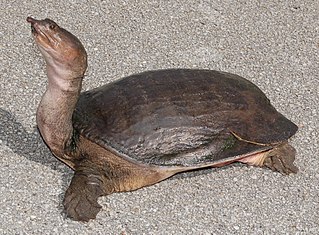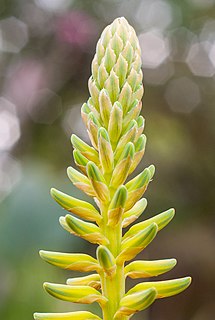
Aloe, also written Aloë, is a genus containing over 550 species of flowering succulent plants. The most widely known species is Aloe vera, or "true aloe". It is called this because it is cultivated as the standard source for assorted pharmaceutical purposes. Other species, such as Aloe ferox, are also cultivated or harvested from the wild for similar applications.

Tequila is a distilled beverage made from the blue agave plant, primarily in the area surrounding the city of Tequila 65 km (40 mi) northwest of Guadalajara, and in the Jaliscan Highlands of the central western Mexican state of Jalisco.

Sisal, with the botanical name Agave sisalana, is a species of flowering plant native to southern Mexico but widely cultivated and naturalized in many other countries. It yields a stiff fibre used in making rope and various other products. The term sisal may refer either to the plant's common name or the fibre, depending on the context. It is sometimes referred to as "sisal hemp", because for centuries hemp was a major source for fibre, and other fibre sources were named after it.

Mezcal is a distilled alcoholic beverage made from any type of maguey. The word mezcal comes from Nahuatl mexcalli[meʃˈkalːi], which means "oven-cooked agave", from metl[met͡ɬ] and ixcalli[iʃˈkalːi]. Traditionally the word "mezcal" has been used generally in Mexico for all maguey spirits and it continues to be used for many maguey spirits whether these spirits have been legally certified as "mezcal" or not.

Agave americana, common names century plant, maguey, or American aloe, is a species of flowering plant in the family Asparagaceae, native to Mexico and the United States in Texas. It is cultivated worldwide as an ornamental plant, and has been naturalized in many regions, including parts of the West Indies, South America, the southern Mediterranean Basin, Africa, India, China, Thailand, and Australia.
Maguey may refer to various American plants:

Alepisaurus ferox, the long snouted lancetfish, longnose lancetfish, or cannibal fish, is a species of lancetfish found in the ocean depths down to 1,830 m (6,000 ft). This species grows to 215 cm (85 in) in total length and a weight of 9 kg (20 lb).

Agave lechuguilla is an Agave species found only in the Chihuahuan Desert, where it is an indicator species. It typically grows on calcareous soils. The plant flowers once in its life and then dies. The flowers are a source of nutrients for insects, bats, and some birds.

Agave syrup, also known as maguey syrup or agave nectar, is a sweetener commercially produced from several species of agave, including Agave tequilana and Agave salmiana. Blue-agave syrup contains 56% fructose as a sugar providing sweetening properties.

The Florida softshell turtle is a species of softshell turtle native to the Southeastern United States.
Tectiphiala ferox, or palmiste bouglé, is a species of flowering plant in the family Arecaceae. It is endemic to Mauritius. It is threatened by habitat loss. It is the sole species in the genus Tectiphiala. Tectiphiala ferox was not known until 1965 when this new species of the Mascarene palm was discovered near Grand Bassin by Marc d"Unienville.

Agave salmiana is a species of the family Asparagaceae, native to central and southern Mexico. It is also reportedly naturalized in South Africa, Italy and Spain, specially in the Canary Islands.

Agave is a genus of monocots native to the hot and arid regions of the Americas, although some Agave species are also native to tropical areas of South America. The genus Agave is primarily known for its succulent and xerophytic species that typically form large rosettes of strong, fleshy leaves. Agave now includes species formerly placed in a number of other genera, such as Manfreda, ×Mangave, Polianthes and Prochnyanthes.

The Jardin botanique d'Èze, also called the Jardin exotique d'Èze or simply the Jardin d'Èze, is a botanical garden located on the Place du Général de Gaulle in Èze, Alpes-Maritimes, Provence-Alpes-Côte d'Azur, France.

Don Julio is a brand of tequila produced in Mexico. It is the largest brand in value and eighth largest in volume. It is distilled, manufactured, bottled, sold, and distributed by Tequila Don Julio, S.A. de C.V. from its corporate facility in the Colonia El Chichimeco district, in the city of Atotonilco El Alto, Jalisco, Mexico. It is distributed in the United States by Diageo, under licensing from its patent holder, Tequila Don Julio, Sociedad Anónima de Capital Variable, Jalisco, Mexico, but it is sold worldwide.
Comadia redtenbacheri is a moth in the family Cossidae. It is found in North America, where it has been recorded from Mexico and southern Texas.

Agave atrovirens, called maguey verde grande is a type of century plant native to Oaxaca, Pueblo and Veracruz states in Mexico. It is the largest of all the Agaves, occasionally reaching a weight of two long tons. Each succulent leaf can be up to 14 feet 9 inches in length and weigh one hundred pounds (45 kg) apiece. In the variety A. a. cochlearis these leaves can also be up to 16 inches (41 cm) wide. As in other Agaves the leaves form a rosette, from the center of which, after many years, a panicle of flowers emerges on a long scape or peduncle which at first looks like a vast stalk of asparagus, but later grows to more than forty feet in height, develops side branches near the top and numerous flowers which open red and gradually turn yellow. Agave salmiana, the species with the tallest inflorescences, is frequently lumped with A. atrovirens as the varieties A. a. salmiana or A. a. sigmatophylla. If this is valid, then A. atrovirens also has the tallest inflorescences of any Agave, and of any known plant. Each rosette flowers and fruits once, then dies. According to Fayaz this is one of the species which makes offsets or "pups". A. atrovirens is one of the pulque agaves used in the production of mezcal.

The maguey flower, in Spanish, flor de maguey, also known locally as gualumbo, hualumbo, quiote or jiote is a typical product of Mexican cuisine, cultivated mainly in the rural areas of the center of the country. Due to its difficult availability, it is considered a delicacy. Maguey flowers are harvested and consumed closed, since once opened (ripened), they have a bitter taste.














